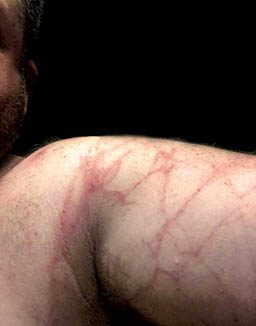Cutaneous decompression sickness (DCS), or “skin bends,” most often manifests as skin mottling on the torso, upper arms and buttocks to various degrees. An associated marbled look to the skin is sometimes referred to as cutis marmorata. While cutaneous DCS is most likely related to gas occurring in body — after decompression or due to lung barotrauma or some medical procedures — there generally is no accepted explanation how the free gas is related to skin changes.
Possible explanations include the occurrence of gas bubbles in subcutaneous tissues, occlusion of subcutaneous arteries with circulating bubbles bypassing the lung filter (as with a patent foramen ovale), inflammatory reaction bubbles present locally or bubbles causing endothelial injury at remote locations.

In a recently published paper, Kemper and colleagues1 present a novel hypothesis that links skin changes to overt or subclinical brain changes caused by cerebral arterial gas embolism (AGE). The research team from the Netherlands experimentally studied AGE in anesthetized pigs, with a focus on the effects of AGE on brain functions.2 However, they noticed that within minutes of injecting gas bubbles into cerebral circulation, a mottling appeared on the animal’s skin that resembled marbled skin characteristic of DCS in humans. They hypothesized that the brain injury resulting from the injection of gas bubbles led to a release of neuropeptides by sensory nerves in the skin, which initiated an inflammatory response and the appearance of skin mottling.
Skin mottling can occur without diving and inert gas dissolved in subcutaneous tissue, such as when cerebral AGE develops due to medical interventions or spontaneous lung rupture.
Several unrelated clinical conditions have been associated with skin mottling. One condition that appears to make this hypothesis of brain involvement in skin DCS feasible is Sneddon’s syndrome, a rare vasculopathy (disease of the blood vessels) that is often preceded by skin mottling called livedo racemosa. By appearance and distribution over the body, it is much like cutis marmorata in skin DCS. The study’s authors propose that cutis marmorata in human DCS is caused by a cerebral injury that does not always produce symptoms.
While this is just a hypothesis, it is worth of considering possible practical implications. DAN injury data analysis as presented in various editions of the DAN Annual Report indicate that at least 20 percent of divers with skin DCS also have neurological symptoms that they may not be aware of but were discovered at a clinical examination. The hypothesis presented here suggests strengthening the current recommendations so that divers with skin mottling after a dive should receive a neurological evaluation. Even more, the repeated episodes of skin changes, while in itself may seem innocuous, should be taken seriously as a possible indicator of subclinical brain injury, and the diver’s diving practice should be reviewed and safety measures elevated.
References
- Kemper TCPM, Rienks R, van Ooij PJAM, van Hulst RA. Cutis marmorata in decompression illness may be cerebrally mediated: a novel hypothesis on the aetiology of cutis marmorata. Diving Hyperb Med. 2015 June; 45(2):84-88.
- Van Hulst RA, Lameris TW, Hasan D, Klein J, Lachmann B. Effects of cerebral air embolism on brain metabolism in pigs. Acta Neurol Scand. 2003 August; 108(2):118-24.
- Weenink RP, Hollmann MW, Vrijdag XC, Van Lienden KP, De Boo DW, Stevens MF, et al. Hyperbaric oxygen does not improve cerebral function when started 2 or 4 hours after cerebral arterial gas embolism in swine. Crit Care Med. 2013 July; 41(7):1719-27.